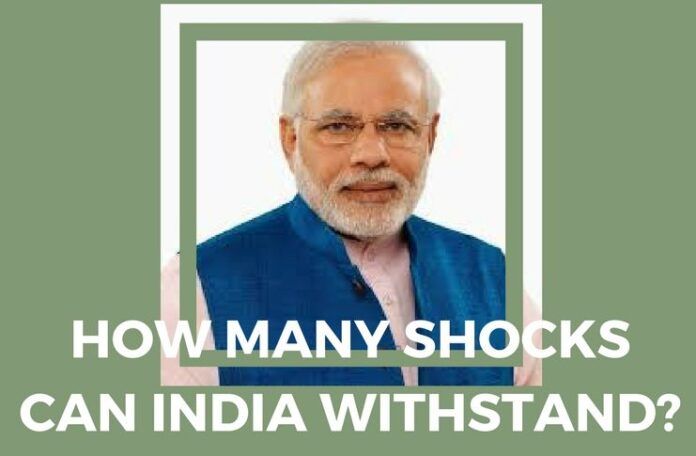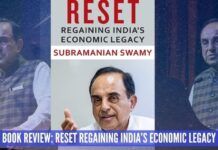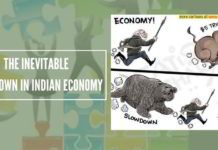
Can India withstand more shocks ?
[dropcap color=”#008040″ boxed=”yes” boxed_radius=”8px” class=”” id=””]T[/dropcap]he Narendra Modi government seems to be hallucinating. For its ambition to successfully leap-frog 40 notches in the World Bank’s Doing Business survey this year is nothing short of daydreaming. Especially, against the backdrop of just one-notch ascent to 130 in the survey that measures the ease of doing business in 190 countries. The modest rise was in normal times; a lot has changed since then—for the worse.
India’s economy has suffered several shocks and disruptions since the time when the World Bank did its last survey. On November 8 last year, Prime Minister Modi suddenly demonetized 86 per cent of the country’s currency; to what avail, nobody has a clue. Apparently, not even the Prime Minister himself. Why did he do it? What objectives did he intend to attain? Well, a variety of objectives has been offered at different points of time—to staunch terror funding, check black money, encourage the digital economy, to usher in the cashless or less-cash economy, to help the poor, etc.,
It is indubitable, though, that demonetization did hit GDP and triggered huge job losses. Worse, it made India look like a country where unpredictability reigned supreme. Still worse, a widespread impression has been created: the move was political rather than economic; it was intended to starve political rivals in Uttar Pradesh of cash. Whatever may be the veracity of the allegation, anti-Modi parties got decimated in the country’s largest state. The natural corollary: if a government could occasion a massive disruption in the economy for pure electoral gains, it can’t be serious about economic development.
[dropcap color=”#008040″ boxed=”yes” boxed_radius=”8px” class=”” id=””]T[/dropcap]The Modi regime’s casual approach towards development and liberalization is already having consequences for job creation. According to a recent report by the Organization of Economic Cooperation & Development (OECD), India’s rate of employment has declined. As it is, job generation was not growing as fast as the number of working-age people; the situation has further got exacerbated in the recent years.
Almost 31 per cent of youth in the 15-29 age group in our country are not in employment, education or training (NEETs). The figure, over twice the OECD average, is more than that of almost every major economy. For China, it is just over 11 per cent.
What lends credence to the OECD figures is the fact that the government’s job creation numbers are equally dismal. While Modi had promised two crore jobs per year, his government has failed to create even 1 per cent of the promise on this count. And yet he is cavalier in his attitude towards the economy and reforms.
[dropcap color=”#008040″ boxed=”yes” boxed_radius=”8px” class=”” id=””]T[/dropcap]here are also other decisions, not taken by his government, but nonetheless adding the elements of unpredictability into the system. The Supreme Court’s order banning the registration or sale of any BS III vehicles from April 1 is one of them. It penalizes the automobile industry; it is based on the changing of goal posts. Auto makers were supposed to stop the manufacture of BS III vehicles from April 1, 2017. But, two days before that deadline, they were told to even stop selling these vehicles. Such judicial overreach is estimated to have cost the sector anything between Rs 12,000 crore and Rs 15,000 crore.
Another Supreme Court decision, delivered in December 2016, prohibiting the sale of liquor within 500 metres of national and state highways is expected to have a bill attached worth Rs 65,000 crore. The crackdown on illegal abattoirs by the Yogi Adityanath government in UP has severely affected the supply lines in the meat business. Then there are demands in other parts to curtail non-vegetarianism.
In such a milieu, how many investors would be willing to come to India? We have never been a favorite of them, as evident from the fact that foreign direct investment (FDI) in India was just 2.1 per cent of its GDP in 2016, whereas it was 4.23 per cent for Brazil and 3.59 per cent for Canada. This is despite the fact that in 2016, FDI in India, at $46.4 billion was at an eight-year high. Worse, FDI in India has contributed little to job creation.
The sum and substance of all this is that the India economy does not have any more capacity or resilience to withstand any more shocks. The sooner Modi realizes this, the better for him and the country. Enough of shock therapy, Mr Prime Minister and Your Lordships.
Note:
1. The views expressed here are those of the author and do not necessarily represent or reflect the views of PGurus.
- Liberty Is Penalized, Violence Goes Untouched - December 21, 2019
- Rahul’s Howdy bloomer - September 22, 2019
- Chidambaram’s hypocrisy - August 22, 2019










